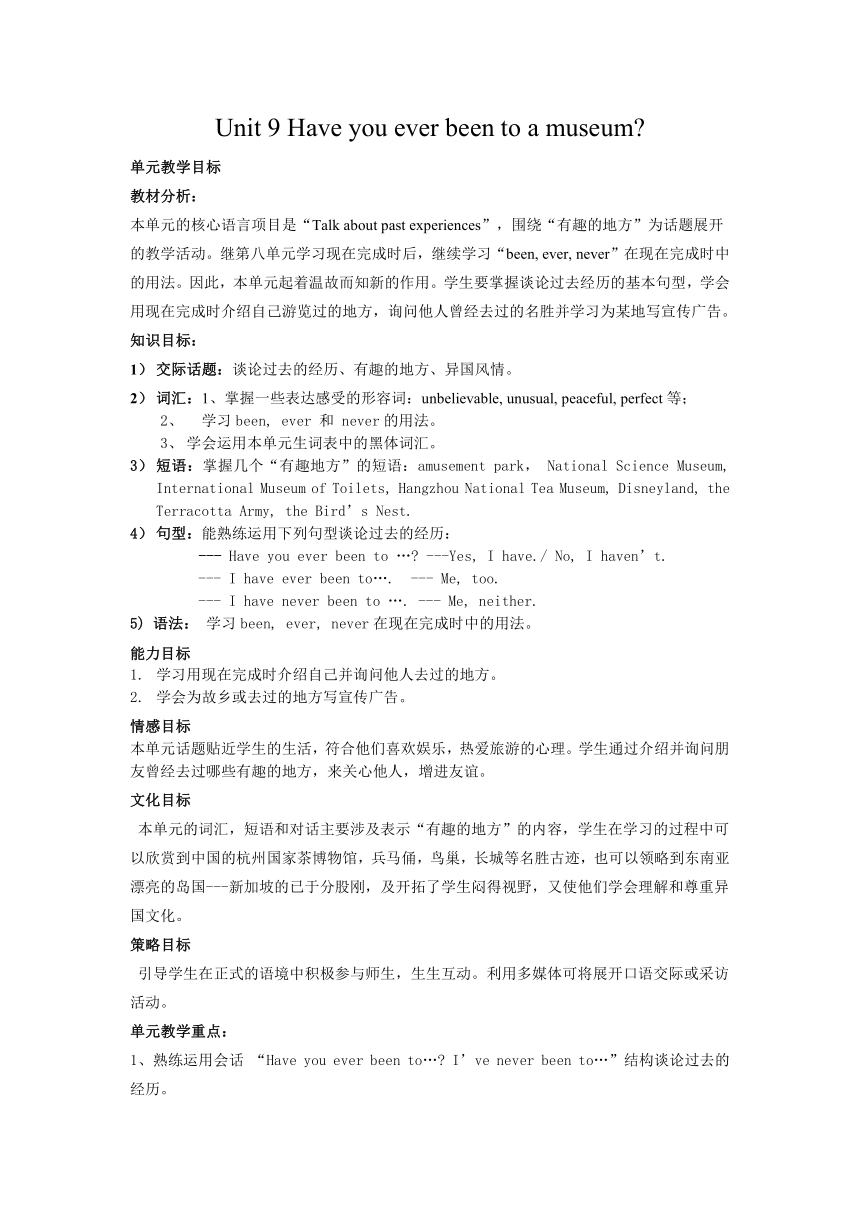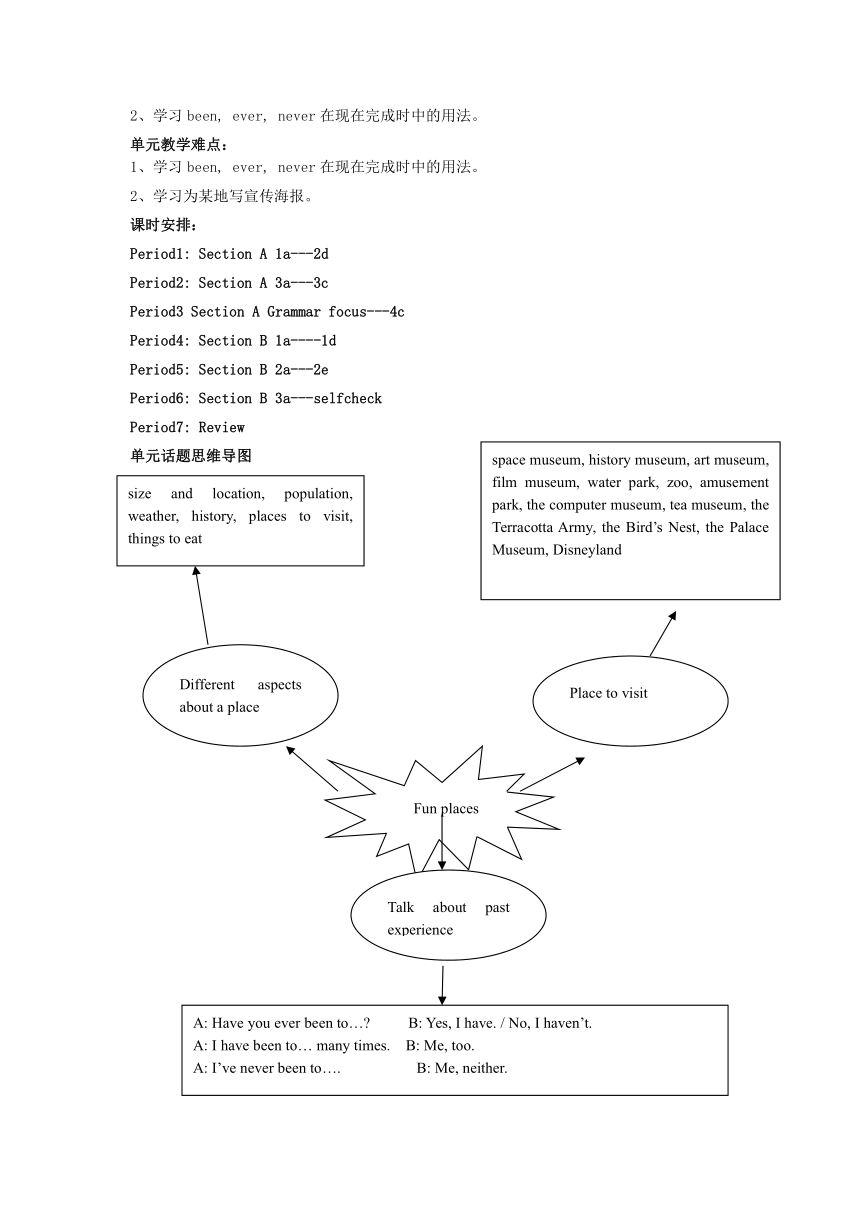Unit 9 Have you ever been to a museum Section A 3a---3c(教案)
文档属性
| 名称 | Unit 9 Have you ever been to a museum Section A 3a---3c(教案) |  | |
| 格式 | doc | ||
| 文件大小 | 56.0KB | ||
| 资源类型 | 教案 | ||
| 版本资源 | 人教新目标(Go for it)版 | ||
| 科目 | 英语 | ||
| 更新时间 | 2022-04-10 11:21:48 | ||
图片预览


文档简介
Unit 9 Have you ever been to a museum
单元教学目标
教材分析:
本单元的核心语言项目是“Talk about past experiences”,围绕“有趣的地方”为话题展开的教学活动。继第八单元学习现在完成时后,继续学习“been, ever, never”在现在完成时中的用法。因此,本单元起着温故而知新的作用。学生要掌握谈论过去经历的基本句型,学会用现在完成时介绍自己游览过的地方,询问他人曾经去过的名胜并学习为某地写宣传广告。
知识目标:
1) 交际话题:谈论过去的经历、有趣的地方、异国风情。
2) 词汇:1、掌握一些表达感受的形容词:unbelievable, unusual, peaceful, perfect等;
2、 学习been, ever 和 never的用法。
3、 学会运用本单元生词表中的黑体词汇。
3) 短语:掌握几个“有趣地方”的短语:amusement park, National Science Museum, International Museum of Toilets, Hangzhou National Tea Museum, Disneyland, the Terracotta Army, the Bird’s Nest.
4) 句型:能熟练运用下列句型谈论过去的经历:
--- Have you ever been to … ---Yes, I have./ No, I haven’t.
--- I have ever been to…. --- Me, too.
--- I have never been to …. --- Me, neither.
5) 语法: 学习been, ever, never在现在完成时中的用法。
能力目标
1. 学习用现在完成时介绍自己并询问他人去过的地方。
2. 学会为故乡或去过的地方写宣传广告。
情感目标
本单元话题贴近学生的生活,符合他们喜欢娱乐,热爱旅游的心理。学生通过介绍并询问朋友曾经去过哪些有趣的地方,来关心他人,增进友谊。
文化目标
本单元的词汇,短语和对话主要涉及表示“有趣的地方”的内容,学生在学习的过程中可以欣赏到中国的杭州国家茶博物馆,兵马俑,鸟巢,长城等名胜古迹,也可以领略到东南亚漂亮的岛国---新加坡的已于分股刚,及开拓了学生闷得视野,又使他们学会理解和尊重异国文化。
策略目标
引导学生在正式的语境中积极参与师生,生生互动。利用多媒体可将展开口语交际或采访活动。
单元教学重点:
1、熟练运用会话 “Have you ever been to… I’ve never been to…”结构谈论过去的经历。
2、学习been, ever, never在现在完成时中的用法。
单元教学难点:
1、学习been, ever, never在现在完成时中的用法。
2、学习为某地写宣传海报。
课时安排:
Period1: Section A 1a---2d
Period2: Section A 3a---3c
Period3 Section A Grammar focus---4c
Period4: Section B 1a----1d
Period5: Section B 2a---2e
Period6: Section B 3a---selfcheck
Period7: Review
单元话题思维导图
Period2
1. 本课教材分析
通过阅读文章,学习用现在完成时介绍自己并询问他人去过的地方。
2. 本课学情分析
(1)通过第八单元以及第九单元第一课时的学习,学生已经对现在完成时有一定掌握.
(2)学生们已经学习了并掌握了一些用来表述有趣地方的短语如:space museum, history museum, art museum, water park, amusement park.
(3) 学生通过第一课时的学习能够使用现在完成时的句型I have been to….
3.教学目标:
1. 知识和能力目标:
(1)90%的学生通过讲学稿预习、师友互助能够读准11个新单词和3个新短语、能够熟记汉语意思及拼写。
(2)85%的学生能够根据教材中提供的篇章信息再次感知理解I have been to句型。
(3) 通过阅读材料,70%的学生能够通过阅读、诵读等阅读方式再次通过信息提取感知、观察ever, never在现在完成时的运用。
2. 过程和方法
(1) 任务教学法。(answer the questions)
(2) 阅读策略。(skimming, scanning, careful reading, summarize)
3. 情感态度价值观
学生通过文章感知学会谈论曾经去过哪些有趣的地方,并谈论感受,学会分享美好的事物,培养学生热爱旅游,了解人文知识及自然知识的意识,开阔学生视野。
4. 教学重点
(1)80%的学生能够通过阅读感知单词:unbelievable, progress, rapid, unusual, toilet, encourage, social, peaceful, prefect itself, collect并理解这些四会单词的汉意。
并通过80%的学生朗读等够正确读准这些四会单词的读音。
(2)重点句型:75%的学生能够通过阅读篇章感知重点句型I have ever been to….
并能感知后能够有75%的学生可以熟练掌握运用该句型谈论介绍自己去过的地方及感受。
5.教学难点:
75%的学生能够通过阅读篇章让学生感知、观察、总结been、 ever在现在完成时中的用法。
6. 课前准备:
(1)教师准备工作:课件
(2)学生准备:认读新单词,识记 新单词
7. 教学步骤:
Step 1: Lead-in: Use a song.
Ask students “ Have you ever been to Georgia ”
What should we need if you go to a new place
Today, let’s find the best guide. And you should finish 4 challenges.
Step 2 : Pairwork (Challenges 1 Interview.)
Work as a guide, you should have good speaking skill.
Q: Have you ever been somewhere interesting
Where have you ever been to
Who did you go with
What do you think of it
Step3: Reading. (Challenges 2: Read and get useful information.)
Work as a guide, sometimes you need to get useful information in the materials. Read and use different reading skills to get useful information.
1. Task1 Skimming and answer the question.
Which three museums do the students talk about
2. Task2 Scanning and fill in the table
Fun places Feeling Facts
Unbelievable
The Museum of Toilets
The tea art performances show how to make a perfect cup of tea with beautiful tea sets.
3.Task 3 Work as a guide, you should use your own words to explain some useful information to your tourists.
Careful Reading (Fill in the blanks)
In the American Computer Museum, we can have information about different computers and who made / ______ them. It’s ___________ (believe) that technology has progressed in such a r______/quick way! There was a special computer. It could play chess even better than humans.
There is a very uncommon / __________ museum in India, the International Museum of Toilets. Amy just couldn’t _________ (believe) her eyes when she saw so many different kinds of toilets there. It encourages governments and social groups to think about ways to i____________ (become better) toilets in the future.
The Hangzhou National Tea Museum is a _________ (relax) and quiet/ ___________ place near a lake. Watching te tea preparation is just as e______________ as drinking the tea itself.
Step4: Extensive reading. (Challange3: Read the extensive reading and summarize information)
Work as a guide, you have to use your own sentences to tell information to your tourists. So read the extensive reading and summarize information.
Size and location:
Population:
Language:
Weather:
Place to visit:
Things to eat:
Step5: Writing. (Talk about your past traveling experience)
Where have you ever been
Tell us the feeling and the facts.
space museum, history museum, art museum, film museum, water park, zoo, amusement park, the computer museum, tea museum, the Terracotta Army, the Bird’s Nest, the Palace Museum, Disneyland
size and location, population, weather, history, places to visit, things to eat
Place to visit
Different aspects about a place
Fun places
Talk about past experience
A: Have you ever been to… B: Yes, I have. / No, I haven’t.
A: I have been to… many times. B: Me, too.
A: I’ve never been to…. B: Me, neither.
单元教学目标
教材分析:
本单元的核心语言项目是“Talk about past experiences”,围绕“有趣的地方”为话题展开的教学活动。继第八单元学习现在完成时后,继续学习“been, ever, never”在现在完成时中的用法。因此,本单元起着温故而知新的作用。学生要掌握谈论过去经历的基本句型,学会用现在完成时介绍自己游览过的地方,询问他人曾经去过的名胜并学习为某地写宣传广告。
知识目标:
1) 交际话题:谈论过去的经历、有趣的地方、异国风情。
2) 词汇:1、掌握一些表达感受的形容词:unbelievable, unusual, peaceful, perfect等;
2、 学习been, ever 和 never的用法。
3、 学会运用本单元生词表中的黑体词汇。
3) 短语:掌握几个“有趣地方”的短语:amusement park, National Science Museum, International Museum of Toilets, Hangzhou National Tea Museum, Disneyland, the Terracotta Army, the Bird’s Nest.
4) 句型:能熟练运用下列句型谈论过去的经历:
--- Have you ever been to … ---Yes, I have./ No, I haven’t.
--- I have ever been to…. --- Me, too.
--- I have never been to …. --- Me, neither.
5) 语法: 学习been, ever, never在现在完成时中的用法。
能力目标
1. 学习用现在完成时介绍自己并询问他人去过的地方。
2. 学会为故乡或去过的地方写宣传广告。
情感目标
本单元话题贴近学生的生活,符合他们喜欢娱乐,热爱旅游的心理。学生通过介绍并询问朋友曾经去过哪些有趣的地方,来关心他人,增进友谊。
文化目标
本单元的词汇,短语和对话主要涉及表示“有趣的地方”的内容,学生在学习的过程中可以欣赏到中国的杭州国家茶博物馆,兵马俑,鸟巢,长城等名胜古迹,也可以领略到东南亚漂亮的岛国---新加坡的已于分股刚,及开拓了学生闷得视野,又使他们学会理解和尊重异国文化。
策略目标
引导学生在正式的语境中积极参与师生,生生互动。利用多媒体可将展开口语交际或采访活动。
单元教学重点:
1、熟练运用会话 “Have you ever been to… I’ve never been to…”结构谈论过去的经历。
2、学习been, ever, never在现在完成时中的用法。
单元教学难点:
1、学习been, ever, never在现在完成时中的用法。
2、学习为某地写宣传海报。
课时安排:
Period1: Section A 1a---2d
Period2: Section A 3a---3c
Period3 Section A Grammar focus---4c
Period4: Section B 1a----1d
Period5: Section B 2a---2e
Period6: Section B 3a---selfcheck
Period7: Review
单元话题思维导图
Period2
1. 本课教材分析
通过阅读文章,学习用现在完成时介绍自己并询问他人去过的地方。
2. 本课学情分析
(1)通过第八单元以及第九单元第一课时的学习,学生已经对现在完成时有一定掌握.
(2)学生们已经学习了并掌握了一些用来表述有趣地方的短语如:space museum, history museum, art museum, water park, amusement park.
(3) 学生通过第一课时的学习能够使用现在完成时的句型I have been to….
3.教学目标:
1. 知识和能力目标:
(1)90%的学生通过讲学稿预习、师友互助能够读准11个新单词和3个新短语、能够熟记汉语意思及拼写。
(2)85%的学生能够根据教材中提供的篇章信息再次感知理解I have been to句型。
(3) 通过阅读材料,70%的学生能够通过阅读、诵读等阅读方式再次通过信息提取感知、观察ever, never在现在完成时的运用。
2. 过程和方法
(1) 任务教学法。(answer the questions)
(2) 阅读策略。(skimming, scanning, careful reading, summarize)
3. 情感态度价值观
学生通过文章感知学会谈论曾经去过哪些有趣的地方,并谈论感受,学会分享美好的事物,培养学生热爱旅游,了解人文知识及自然知识的意识,开阔学生视野。
4. 教学重点
(1)80%的学生能够通过阅读感知单词:unbelievable, progress, rapid, unusual, toilet, encourage, social, peaceful, prefect itself, collect并理解这些四会单词的汉意。
并通过80%的学生朗读等够正确读准这些四会单词的读音。
(2)重点句型:75%的学生能够通过阅读篇章感知重点句型I have ever been to….
并能感知后能够有75%的学生可以熟练掌握运用该句型谈论介绍自己去过的地方及感受。
5.教学难点:
75%的学生能够通过阅读篇章让学生感知、观察、总结been、 ever在现在完成时中的用法。
6. 课前准备:
(1)教师准备工作:课件
(2)学生准备:认读新单词,识记 新单词
7. 教学步骤:
Step 1: Lead-in: Use a song.
Ask students “ Have you ever been to Georgia ”
What should we need if you go to a new place
Today, let’s find the best guide. And you should finish 4 challenges.
Step 2 : Pairwork (Challenges 1 Interview.)
Work as a guide, you should have good speaking skill.
Q: Have you ever been somewhere interesting
Where have you ever been to
Who did you go with
What do you think of it
Step3: Reading. (Challenges 2: Read and get useful information.)
Work as a guide, sometimes you need to get useful information in the materials. Read and use different reading skills to get useful information.
1. Task1 Skimming and answer the question.
Which three museums do the students talk about
2. Task2 Scanning and fill in the table
Fun places Feeling Facts
Unbelievable
The Museum of Toilets
The tea art performances show how to make a perfect cup of tea with beautiful tea sets.
3.Task 3 Work as a guide, you should use your own words to explain some useful information to your tourists.
Careful Reading (Fill in the blanks)
In the American Computer Museum, we can have information about different computers and who made / ______ them. It’s ___________ (believe) that technology has progressed in such a r______/quick way! There was a special computer. It could play chess even better than humans.
There is a very uncommon / __________ museum in India, the International Museum of Toilets. Amy just couldn’t _________ (believe) her eyes when she saw so many different kinds of toilets there. It encourages governments and social groups to think about ways to i____________ (become better) toilets in the future.
The Hangzhou National Tea Museum is a _________ (relax) and quiet/ ___________ place near a lake. Watching te tea preparation is just as e______________ as drinking the tea itself.
Step4: Extensive reading. (Challange3: Read the extensive reading and summarize information)
Work as a guide, you have to use your own sentences to tell information to your tourists. So read the extensive reading and summarize information.
Size and location:
Population:
Language:
Weather:
Place to visit:
Things to eat:
Step5: Writing. (Talk about your past traveling experience)
Where have you ever been
Tell us the feeling and the facts.
space museum, history museum, art museum, film museum, water park, zoo, amusement park, the computer museum, tea museum, the Terracotta Army, the Bird’s Nest, the Palace Museum, Disneyland
size and location, population, weather, history, places to visit, things to eat
Place to visit
Different aspects about a place
Fun places
Talk about past experience
A: Have you ever been to… B: Yes, I have. / No, I haven’t.
A: I have been to… many times. B: Me, too.
A: I’ve never been to…. B: Me, neither.
同课章节目录
- Unit 1 What's the matter?
- Section A
- Section B
- Unit 2 I'll help to clean up the city parks.
- Section A
- Section B
- Unit 3 Could you please clean your room?
- Section A
- Section B
- Unit 4 Why don't you talk to your parents?
- Section A
- Section B
- Unit 5 What were you doing when the rainstorm came
- Section A
- Section B
- Review of Units 1-5
- Unit 6 An old man tried to move the mountains.
- Section A
- Section B
- Unit 7 What's the highest mountain in the world?
- Section A
- Section B
- Unit 8 Have you read Treasure Island yet?
- Section A
- Section B
- Unit 9 Have you ever been to a museum?
- Section A
- Section B
- Unit 10 I've had this bike for three years.
- Section A
- Section B
